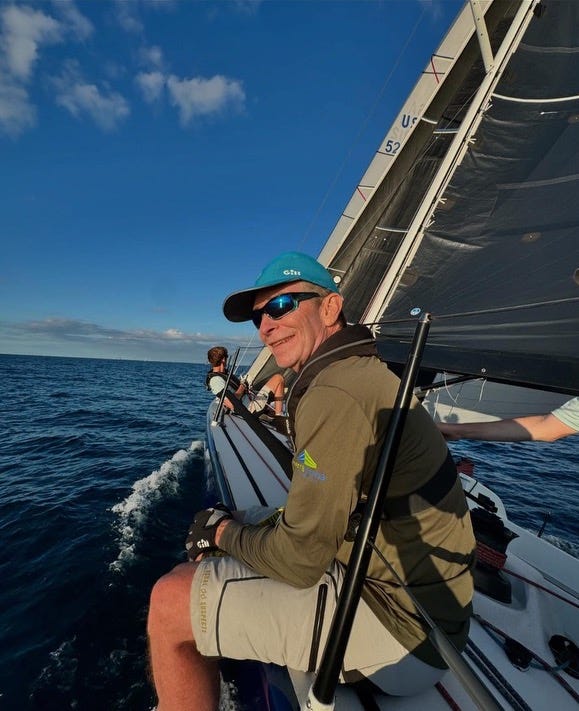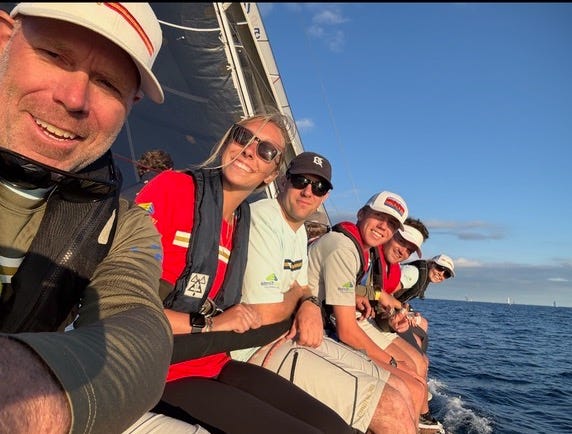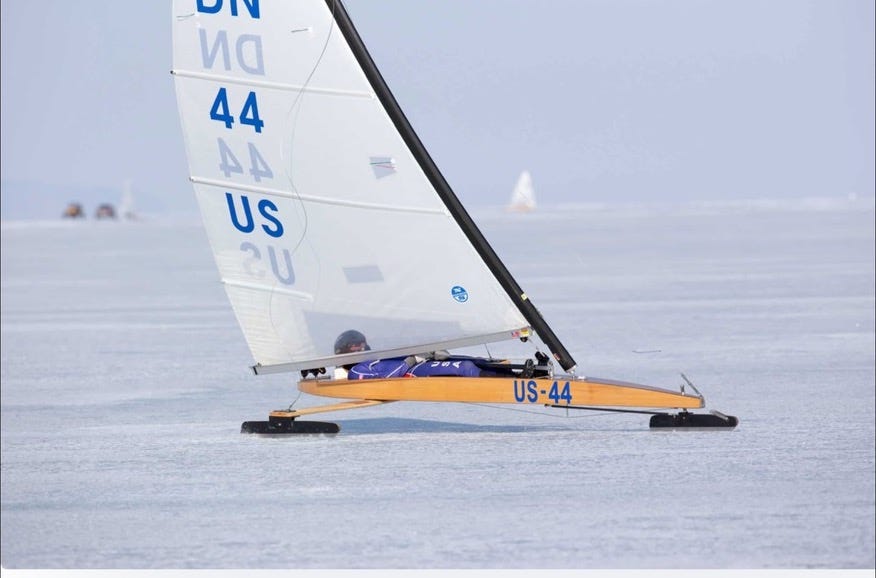Champion sailor Ron Sherry: Yelling never made anyone faster or better
Helmsman explains why the mental game is key to victory
Ron Sherry has spent half a century (literally) steering sailboats to victory.
He has won North American sailing championships in multiple classes plus world ice boating championships eight times.
“The thing about being a helmsman is that it’s a very tough position, not so much physically demanding as mentally demanding. You absolutely have to stay focused on what you’re doing,” Sherry, 63, of Clinton Township, Mich., told Shifting Gears.
“You’re watching the waves, the wind direction, all the instruments — and shifts of wind and pressure changes,” he said.
Telltales — those tiny ribbons on the sail — provide wind guidance for the helmsman. The goal is to have telltales streaming straight back. If a telltale on the windward side is bouncing or going forward, the sail needs to be trimmed, Sherry said. If the telltale on the leeward side is flapping, the sail needs to be eased.
For 26 years, he guided multiple sailboats named Equation, owned by Bill Alcott of St. Clair Shores, Mich., to victories in the Port Huron to Mackinac and Chicago to Mackinac races.
“His boat rules were simple - no shouting, always show up with a hangover and the last guy to report buys drinks for everyone,” said a 2020 obituary for Alcott that included a shoutout to all crew members who raced with him.
No yelling with special exceptions
Every boat has a distinct personality shaped by the skipper, Sherry said.
“I try to never, ever, ever yell. If I yell, it’s so that another boat hears me and sees me and we don’t get into a collision. That’s the only real reason, in my mind, to yell. Or, if it’s windy and people on the boat can’t hear you,” he said. “I’ve sailed with several skippers who love to yell at their crew. I usually don’t return to sail on those boats.”
People don’t respond well when they get yelled at in front of others, Sherry said.
“You’re not going to make a person better by yelling at them,” he said. “Express what you want them to do. If you want to make a person better, wait until you’re in between races, bring up the subject, let them talk about what they think they should have done. Then say, ‘Here’s what I’ve done in the past,’ and work it out one on one. Don’t yell at someone in front of the whole crew. It makes good people uncomfortable.”

This month, Sherry will sail both Mackinac races on Usual Suspects, a Reichel/Pugh TP52 owned by Eric Wynsma of Harbor Springs, Mich. Sherry will be secondary helmsman, trim sails and support the crew where needed.
“I just love the art of sailing — shaping the sails, analyzing the conditions and trying to make whatever boat I’m on go as fast as we can,” he said.
36 second margin in 6 hours of racing
Sherry started racing Thistle sailboats at age 9 with a kind sailor his father knew from Crescent Sail Yacht Club in Grosse Pointe Farms, Mich.
Sherry’s dad, Lorne, who sailed in more than 25 Mackinac races, was also a world champion in the Renegade ice boat class. He knew yelling would diminish the young boy’s love of sailing. The father-son team later competed in the 1984 Olympic trials for sailing in the Tornado class in Long Beach, Calif.
(Lorne Sherry, chief trailering engineer for General Motors, designed and tested trailer hitches for a living. He testified on behalf of Chevrolet as an expert witness in court case involving trailering accidents. Lorne Sherry usually carried boats on the roof of a station wagon or Suburban instead of a trailer.)
On the day of our interview, Ron Sherry had just returned from racing Usual Suspects across Lake Michigan in the Queen’s Cup from Milwaukee, Wis., to Muskegon, Mich., on June 27, 2025. They placed third, just 36 seconds out of second place — after racing 65 nautical miles in six hours, 20 minutes.
“You’re always trying to guess what the wind’s going to do. And what currents do you have,” Sherry said. “The current in the Detroit River is much more substantial than the current on Lake St. Clair. You have to take advantage of all Mother Nature has to offer and put in your favor.”
Race starts: 3 min prep
Before starting a race, a helmsman needs to get wind readings, look at the course and assess currents, he said. Then figure out wind pressure.
About 3 minutes before a start, you’ll catch Sherry every time in the middle of a starting line, pointing the bow straight into the wind. He wants to determine which end (of the start line) is best, based on wind direction, current and starting line angle.
Too often, he said, boats just sail back and forth at the starting line to kill time. The best sailors want to figure out which side of the boat has more breeze and really focus on strategy, he said.

“The biggest mistake I see is people getting too far from the starting line,” he said. “I like to stay in between the buoy and the committee boat … People often don’t make it back in time for their start.”
Long-distance racing
A helmsman, more than anyone, needs to be rested. Veteran sailors tell stories of hallucinating when exhausted.
“When you’re off watch, you must lay down,” Sherry said. “ This is so, when you are driving, you can focus and work with the main sail trimmers. You need to learn how to anticipate (wind) puffs and steer flat. Keeping yourself hydrated is important.”
A good helmsman counts on every sailor to focus on their own job and do it well.
Nobody is more essential than anyone else, Sherry said.
“I try to make everybody feel equally important. If you don’t have a good bowman, you can’t get your sails up and down, you can’t get around the corners. The navigator is going to be the one telling you about (wind) shifts coming, where you get more breeze, what currents are doing,” he said.
“The main sail trimmer is the gas pedal and helps you keep the boat flat and fast. If the boat gets hit by a puff (of wind), the main sail trimmer needs to quickly ease the sail. If the boat tips over, it drifts sideways and goes slower.”
Stay current
On the way out to the race course, a crew meeting is really important.
You want to make sure the whole crew is on the same page in terms of which sails you’ll likely be using, where you want the crew weight, which marks are on port and starboard sides of the boat, Sherry said. “Everybody is involved in conversation.”
Note: The left side of the boat is port. The right side of the boat is starboard. When the wind is coming across from the right side of the boat, you’re on starboard tack and have the right of way. If wind is coming over the left side of the boat, you’re on port tack.
After a race, debriefing is key, Sherry said. A helmsman may realize they should have asked for actions sooner. Sails can get hooked on the hatch, all sorts of things happen.
“You want to talk about issues without trying to point fingers or blaming anybody,” Sherry said. “You all want to be better next time. Sailing is always learning.”
With and without ice
Winning races on frozen and unfrozen water requires similar skill, he said.
“The big thing is having the boat prepared and having your sails and equipment right for different conditions,” Sherry said. “You make changes based on those conditions, whether it’s glass ice, bumpy ice, snow drifts or steady snow — or sailing in chop, flat water, shifty winds. All the variables. It’s all about the art of sailing.”
Sherry, a longtime sailmaker who also built masts made of carbon fiber and fiberglass for America’s Cup boats, now develops durable components for ice boats and sail boats. His company, Composite Concepts, has supplied masts, custom hulls and hardware to buyers worldwide including Europe, Asia, Russia, and China for three decades.
Sherry credits much of how he approaches sailing to T.K. Lowry of Grosse Pointe Shores, Mich., who owned a winning series of sailboats named Tomahawk. Sherry raced with Lowry on boats small and large, nationally.
“He was one of my true mentors. On distance races, I’d be second helmsman,” said Sherry, a board member at Crescent Sail Yacht Club. “I would talk to T.K. before I bought a truck, went to college, got married or bought a house. He would always do more listening than speaking. And the answers would become very obvious. I hope I get to do that for people ...”
This article part of an annual summer series on sailboat racing. Find all sailor stories here
Phoebe Wall Howard, a Grosse Pointe native, covered sailing for The Detroit Free Press for seven years, until 2024.
World champion who races Mackinac: Mistakes to avoid
Eagle One skipper reveals why he agreed to sponsor Mackinac race (again)
Sailor beats death under moonless sky
Note: I’m a proud member of the Iowa Writers’ Collaborative. Please check out a great mix of political analysis, features and news from the Heartland here







Our friends Jim Jelsone and wife Frances (Elaine) took part in the Port Huron to Mac race for many years. They kept their boat at the Detroit Edison boat dock which I think is down the street from Baypoint. He loved sailing, but last I heard their sailboat was sold and no more sailing as they enjoy retirement down in the Carolinas. Both Denby HS graduates, Elaine was very close to my late wife Sharon, both grew up on Camden St. in Detroit near Gunston & Harper Ave and attended DPS Macomb Elementary, the same school that Sonny Bono attended as a child!
That's one dedicated sailor. Thanks for enlightening us on the big boy boats!
I truly believe you get more done, more respect, and more cooperation without shouting.
Peace
Gregg